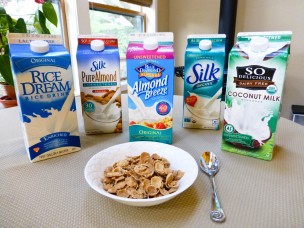It’s no secret that drinking milk after infancy is pretty bad for humans, harming the bones, the heart, and the skin—not to mention the animals from whose teats it’s sucked by industrial machines. We can all take comfort in the knowledge that there is no dearth of non-dairy milk options, in Usdan and elsewhere. Here are our favorite dairy-free milks for every occasion.
The milk: Almond
The taste: Almond milk may be mild, but it’s not meek. Plain and unsweetened, it tastes suspiciously like cows’ milk when poured over cereal, and it’s a good replacement for milk in most baking recipes. Not exactly nutty, but not sweet either, almond milk is unlikely to offend the palate, and unless you opt for the sweetened or flavored variety, you’re unlikely to notice it much at all. Vanilla is similarly straightforward, but chocolate is a whole other story entirely. I recommend beginning with the plainest variety available and working your way up.
Nutrition: Surprisingly low in protein, weighing in with just a single gram, almond milk makes up for this single flaw with its heart-healthy monounsaturated and polyunsaturated fats and healthy dose of calcium (20 percent of your daily needs, in fact) and vitamins D (25 percent) and E (20 percent). You can always eat some whole almonds to meet your protein needs.
The milk: Soy
The taste: Thicker and more assertive than almond milk, soy milk works fantastically in coffee and tea. Like almond milk, it comes in a plethora of flavors and colors, but I’d recommend sticking to the plainest one while you’re getting used to the taste—and besides, it will have less sugar. Another common baking substitute, soy milk is perfect in smoothies, lattes, and hot chocolate.
Nutrition: It’s got some saturated fat, but nothing to get yourself into a tizzy over. More importantly, soy milk provides seven grams of protein per eight-ounce serving and carries with it much-needed potassium and magnesium. Many people get worked up over soy milk’s content of phytoestrogens, which activate the body’s estrogen receptors and play a role in monitoring the body’s estrogen levels. More research needs to be done before we can condemn soy milk, but as of now, doctors agree that unless you’re drinking a diet of only soy milk, a few glasses per week will not hurt you.
The milk: Coconut
The taste: It tastes like, well, coconut. Coconut milk, which works wonderfully in soups and other savory dishes, is one of the most delicious nectars known to man. Sweet, aromatic, and soothing, it tastes like world peace.
Nutrition: As well as providing an important source of healthy fatty acids and saturated fat (not all fat, remember, makes you fat), there is evidence suggesting that coconut milk increases the metabolism, helps fight viruses and bacteria, and decreases the risk of heart disease. Moreover, and perhaps more importantly, it will moisturize your skin and give you nice hair. That said, don’t go crazy with the coconut: a decent amount of fat is healthy, but don’t chug it like water.
The milk: Hemp
The taste: Made from a blend of hemp seeds and water, hemp milk admittedly takes some getting used to. I couldn’t drink it for a few weeks after being introduced to it, because I kept picturing it as the juice from a hippie’s dripping armpit, but that’s a personal issue that I hope you’ll forget immediately. Hemp milk is nuttier than almond milk and has a distinctly creamy, earthy taste. It’s best when poured into a bowl of very flavorful, crunchy cereal.
Nutrition: Hemp milk is a real winner in the nutrition department. Omega-3 fatty acids, Omega-6 fatty acids, a perfect set of 10 essential amino acids, and an impressive lists of vitamins and minerals—you name it, hemp milk has it. It even boasts an “increased mental capacity,” according to collective-evolution.com, as well as a “strong, healthy heart.” Who doesn’t want that?
The milk: Rice
The taste: It might be made from rice, but it sure doesn’t taste like it. Rice milk is sweeter than most of the other milks, and because it’s thick, it’s fantastic if you’re looking for a substitute for cream when making ice cream. If you’re not into making your own ice cream, too, look for Rice Dream in most grocery stores: it’s a downright dilly!
Nutrition: Although it’s more carbohydrate-heavy than dairy milk and all of the other non-dairy milks, it has no cholesterol, so your heart will thank you later. Rice milk isn’t a great source of calcium or protein, but some brands are fortified with calcium, so make sure to read the label. Though it’s low in fat, rice milk is probably the least impressive non-dairy milk option when it comes to nutrition, but it makes up for its failings in flavor.
The milk: Flaxseed
The taste: I was feeling adventurous at It’s Only Natural Market and picked up a carton of flaxseed milk, not sure what to expect. When I tried it, I found that it was even weirder than hemp, but over the course of the next two weeks—which is how long it took me to finish the single carton, even while drinking it daily—I developed an affection for it. It was surprisingly good when mixed with green tea and chilled for a few hours in the freezer.
Nutrition: Another winner in the nutrition department, flaxseed milk has no sugar (and even the flavored varieties are low in sugar) and is an excellent source of Omega-3s. Most brands are fortified with vitamins A, D, and B12, as well as calcium. There’s no protein, but again, that can come from other sources. If you can stomach it, spring for flaxseed milk: it’s damn near perfect.

1 Comment
Christine Kringle
HEMP HEMP HOORAY! @TTBHempPolicy